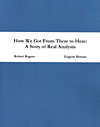- About MAA
- Membership
- MAA Publications
- Periodicals
- Blogs
- MAA Book Series
- MAA Press (an imprint of the AMS)
- MAA Notes
- MAA Reviews
- Mathematical Communication
- Information for Libraries
- Author Resources
- Advertise with MAA
- Meetings
- Competitions
- Programs
- Communities
- MAA Sections
- SIGMAA
- MAA Connect
- Students
- MAA Awards
- Awards Booklets
- Writing Awards
- Teaching Awards
- Service Awards
- Research Awards
- Lecture Awards
- Putnam Competition Individual and Team Winners
- D. E. Shaw Group AMC 8 Awards & Certificates
- Maryam Mirzakhani AMC 10 A Awards & Certificates
- Two Sigma AMC 10 B Awards & Certificates
- Jane Street AMC 12 A Awards & Certificates
- Akamai AMC 12 B Awards & Certificates
- High School Teachers
- News
You are here
How We Got from There to Here: A Story of Real Analysis

Publisher:
Open SUNY Textbooks
Publication Date:
2014
Number of Pages:
206
Format:
Electronic Book
Price:
0 e-book, $18 paperback
ISBN:
9781312348691
Category:
Textbook
[Reviewed by , on ]
P. N. Ruane
10/24/2014
In my ideal world, the first year of every mathematics degree course would include an introductory course on the history of mathematics — perhaps like that provided in Math through the Ages (Berlinghoff and Gouvêa). I also dream about the inclusion of a foundation course on modern geometry, which could be based upon any one from a wide choice of books (including Geometry, by Brannen, Esplen and Gray). I further imagine sound educational reasons for a course based upon Courant and Robbins’s What is Mathematics, which provides much intuitive insight into a wide range of profound mathematical topics that are usually studied in more abstract settings. In subsequent academic years, each course could provide historical perspectives on the mathematical ideas with which it is concerned. One such course could be based upon this recent publication by Robert Rogers and Eugene Boman, who regard it as ‘an introductory analysis textbook presented through the lens of history’.
Although written in the same spirit as David Bressoud’s A Radical Approach to Real Analysis, this book’s format and structure are quite different. For one thing, Bressoud begins with the anomalies that arose when applying calculus to Fourier series, and it ends with an examination of Dirichlet’s resolution of these difficulties. On the other hand, the real analysis of Rogers and Boman kicks off with a comparison of the ideas of Leibniz and Newton on differential calculus, and it culminates with an in-depth examination of the real number system (which is a talking point throughout the book). The innovations due to Fourier are discussed in a chapter called ‘The Man Who Broke Calculus’.
The pedagogical style of this text forms an additional distinguishing feature. For one thing, it has few exercise sets in the usual sense, and readers are often required to solve problems in their historical context. For example, a proof of the Bolzano-Weierstrass theorem is given in outline, and students are asked to fill in the gaps to complete the proof. There are no such exercises for exploration of historical themes, however, which is explained by the fact that the book is not intended as a history of real analysis.
Most of the topics are standard, but their presentation is unusual. Ideas are conveyed in the style of the mathematicians who pioneered them, and they appear in the order of their historical development. The central chapters deal with convergence, Taylor series (integral remainder), limits, continuity, differentiation, integration and uniform convergence. Later chapters are devoted to the real number system, dealing with completeness and methods of construction such as Dedekind cuts and Cauchy sequences. The historical end-point (‘how we got to here’) is marked by the ideas of Paul Cohen (continuum hypothesis) and Kurt Gödel (undecidability), but there is no reference to metric spaces or more general topological ideas.
I very much like the approach adopted by Rogers and Boman, together with its very clear treatment of topics such as ε-δ techniques and convergence of power series. I do, however, have reservations about certain aspects of the book.
- Discussion of the nature of differentials is suspended at the stage when they were infinitesimals (Fréchet could have appeared as a later historical figure).
- Nearly all examples of irrational numbers are algebraic, and the fact that most real numbers are transcendental does not stand out (Courant and Robbins provide a much more accessible portrayal of the real number system)
- Is it really true that it is possible to represent anything more than a subset of rational numbers on a straight line? (p24, 27)
- The process of finding one’s way through this book is made unnecessarily difficult because the index is largely devoted to specifying the location of 30 definitions, 8 lemmas, 57 theorems and 11 corollaries (without saying what they are). Similar comments pertain to the table of contents at the beginning of the book.
- A separate, and more comprehensive, name index would be most useful.
Other than the few quibbles above, I strongly recommend this book for consideration as an alternative approach to real analysis. Despite its title, it is no soft option.
The electronic version of this book can be downloaded from SUNY Open Textbooks. A paperback version is $18.
Peter Ruane has taught mathematics to people between the ages of 5 and 55 — that is, from basic school arithmetic to transfinite arithmetic.
The table of contents is not available.
- Log in to post comments




